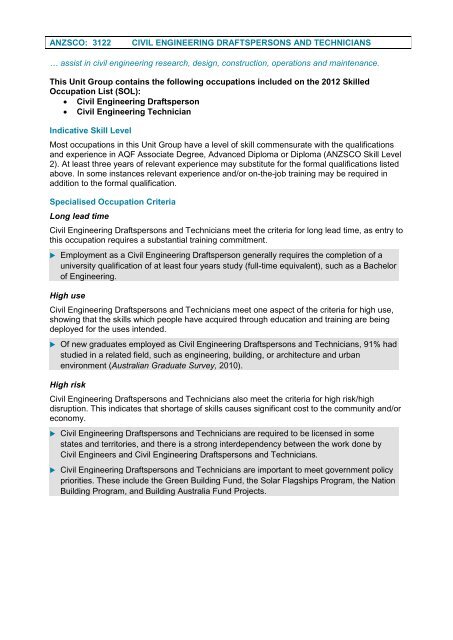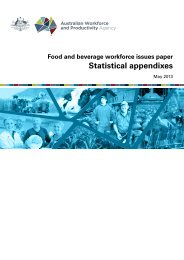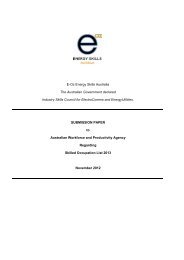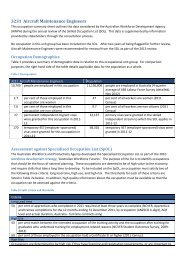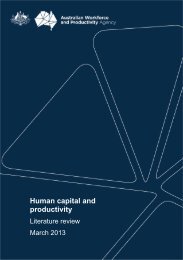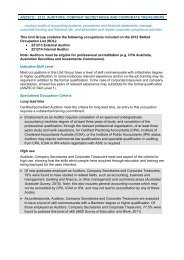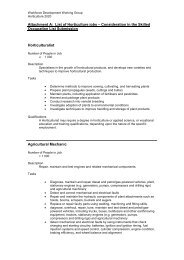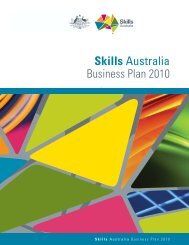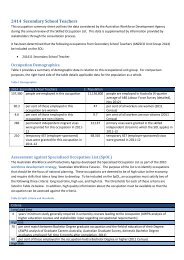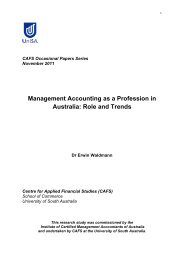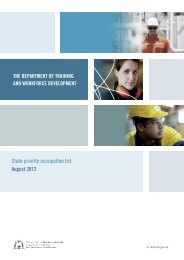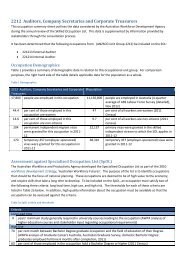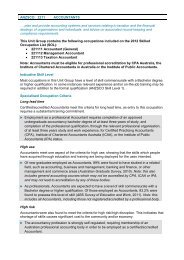ANZSCO: 2414 - AWPA
ANZSCO: 2414 - AWPA
ANZSCO: 2414 - AWPA
Create successful ePaper yourself
Turn your PDF publications into a flip-book with our unique Google optimized e-Paper software.
<strong>ANZSCO</strong>: 3122<br />
CIVIL ENGINEERING DRAFTSPERSONS AND TECHNICIANS<br />
… assist in civil engineering research, design, construction, operations and maintenance.<br />
This Unit Group contains the following occupations included on the 2012 Skilled<br />
Occupation List (SOL):<br />
Civil Engineering Draftsperson<br />
Civil Engineering Technician<br />
Indicative Skill Level<br />
Most occupations in this Unit Group have a level of skill commensurate with the qualifications<br />
and experience in AQF Associate Degree, Advanced Diploma or Diploma (<strong>ANZSCO</strong> Skill Level<br />
2). At least three years of relevant experience may substitute for the formal qualifications listed<br />
above. In some instances relevant experience and/or on-the-job training may be required in<br />
addition to the formal qualification.<br />
Specialised Occupation Criteria<br />
Long lead time<br />
Civil Engineering Draftspersons and Technicians meet the criteria for long lead time, as entry to<br />
this occupation requires a substantial training commitment.<br />
Employment as a Civil Engineering Draftsperson generally requires the completion of a<br />
university qualification of at least four years study (full-time equivalent), such as a Bachelor<br />
of Engineering.<br />
High use<br />
Civil Engineering Draftspersons and Technicians meet one aspect of the criteria for high use,<br />
showing that the skills which people have acquired through education and training are being<br />
deployed for the uses intended.<br />
Of new graduates employed as Civil Engineering Draftspersons and Technicians, 91% had<br />
studied in a related field, such as engineering, building, or architecture and urban<br />
environment (Australian Graduate Survey, 2010).<br />
High risk<br />
Civil Engineering Draftspersons and Technicians also meet the criteria for high risk/high<br />
disruption. This indicates that shortage of skills causes significant cost to the community and/or<br />
economy.<br />
Civil Engineering Draftspersons and Technicians are required to be licensed in some<br />
states and territories, and there is a strong interdependency between the work done by<br />
Civil Engineers and Civil Engineering Draftspersons and Technicians.<br />
Civil Engineering Draftspersons and Technicians are important to meet government policy<br />
priorities. These include the Green Building Fund, the Solar Flagships Program, the Nation<br />
Building Program, and Building Australia Fund Projects.
SOL Summary<br />
Employment in this occupation was rising strongly until late 2010, but over 2011 there was a<br />
marked decline, with the level of employment at November 2011 being 6.0% below its<br />
November 2006 level. However, employment growth is expected to be strong over the next five<br />
years to 2015-16, providing additional openings, and shortages are apparent despite low<br />
activity in employing industries.<br />
The workforce has a relatively old age profile, with around 45% of workers aged 45 years and<br />
over, so replacement demand is likely to provide a significant number of job openings over the<br />
next decade or so. VET completions in recent years have been declining.<br />
The evidence indicates the demand for Civil Engineering Draftspersons and Civil Engineering<br />
Technicians is expected to exceed supply over the medium to longer term.
Occupation trends<br />
<strong>ANZSCO</strong>: 3122<br />
Employment level<br />
6 digit employment<br />
(2006 Census)<br />
Employment growth<br />
Unemployment rate<br />
Civil Engineering Draftspersons and<br />
Technicians<br />
8700 A high proportion of workers (89.6%) are employed full-time.<br />
3122-11 Civil Engineering Draftsperson 4190<br />
3122-12 Civil Engineering Technician 2710<br />
Over the five years to November 2011, employment in this occupation<br />
decreased by 6.0% (compared with growth of 10.4% for all occupations).<br />
Employment over the next five years is expected to increase by 22.3%.<br />
1.1% compared with 3.1% for all occupations.<br />
Educational profile<br />
Vacancies<br />
Gender<br />
Labour turnover<br />
Age profile<br />
34.3% have an Advanced Diploma or Diploma and 26.5% do not hold postschool<br />
qualifications.<br />
The Internet Vacancy Index (IVI) rose by 5.1% over the 12 months to<br />
November 2011. Vacancies for all occupations fell by 7.1%.<br />
11.8% of workers in this occupation are female (compared with 45.5% for all<br />
occupations).<br />
Annually, 10.0% of Building and Engineering Technicians (which includes<br />
Civil Engineering Draftspersons and Technicians) leave their occupation<br />
group, creating some potential job openings (this compares with 14.2%<br />
across all occupations).<br />
The median age is 42 years and 45.1% of workers are aged 45 years and<br />
over (compared with 38.5% for all occupations).<br />
Earnings Median full-time weekly earnings (before tax) are $1350 compared with $1050<br />
for all occupations.<br />
Graduate outcomes<br />
National Centre for Vocational Education Research data are at a highly<br />
aggregated level, combining outcomes across the various engineering<br />
specialities, competitive manufacturing and some textile, clothing and<br />
footwear courses under the title Engineering and related technologies.<br />
However, for this group, 83.0% of 2010 Diploma graduates were employed<br />
(64.9% full-time) six months after graduating, 33.3% of whom were employed<br />
in the occupation group for which they trained.<br />
Skill shortages<br />
National shortages of Civil Engineering Draftspersons and Technicians were<br />
evident between 2006 and 2011, except for 2009.<br />
Labour market<br />
This group is assessed as a single labour market. Widespread shortages were identified between 2006 and<br />
2008 when demand was particularly strong, but the labour market eased in 2009 and shortages abated as<br />
employers received higher numbers of applications and filled a larger proportion of vacancies.<br />
Shortages re-emerged in 2010, and have persisted in 2011. In 2011, slightly more than half the surveyed<br />
vacancies were filled and there were, on average, 1.1 suitable applicants per vacancy (similar to results<br />
recorded in 2010).<br />
Employers generally attract quite large numbers of applications but the vast majority are considered to be<br />
unsuitable for a variety of reasons, including lacking skills on particular software packages, poor<br />
communication skills, and lack of specific experience. The areas for which recruitment is difficult vary across<br />
states and territories but include experience in oil, gas and mining operations and in infrastructure and urban<br />
development.<br />
Department of Education, Employment and Workplace Relations (DEEWR) January 2012
Department of Education, Employment and Workplace Relations (DEEWR) January 2012


